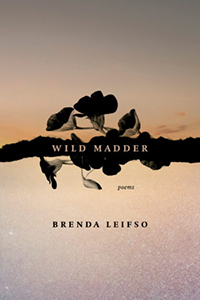Reviews
Poetry Review by Jay Ruzesky
Brenda Leifso, Wild Madder (London: Brick, 2019). Paperbound, 81 pp., $20.00.
 Wild Madder (Latin name: Rubia peregrina) is a woody climber belonging to the coffee family. The plant, which donates its name to Brenda Leifso’s latest poetry collection, appears in a poem about half way through the book in which
Wild Madder (Latin name: Rubia peregrina) is a woody climber belonging to the coffee family. The plant, which donates its name to Brenda Leifso’s latest poetry collection, appears in a poem about half way through the book in which
the afternoon is stretched on the lounger
holding tinfoil under its face
listening to the wind on the radio
and the leaves as they fall
reciting, in no particular order,
the production credits of summer:
Wild Madder. Common Tansy. Sweet Cicely.
Google suggests that the speaker is telling the truth; the plants of the poem are not in any particular order and betray no obvious symbolic value (although Common Tansy is both invasive and an insect repellant—ah HA!). The poem is illustrative of Leifso’s style. Her work is centred on domestic issues of family, home, weather, and urban and natural landscapes and can seem (both in focus and in style) rooted in the mundane. The title of the poem cited above is “We are out of toilet paper” and, let’s face it, doesn’t sound too promising for more than the obvious reason. Her poems generate their power though, by taking ordinary things and straining them through a kind of linguistic cheesecloth until they become concentrated and interesting. Her art is subtle. In the same poem, there is a lack in the autumnal home, described in extraordinary language. Look what she does to let us know the place is dusty and unkempt: she tells us that under the couch we will find that “a thousand days / of dog hair and shed skin / just hosted their third Thanksgiving.” The kind of imagination that can convince us that “days of dog hair” might be capable of hosting a party, or that a lazy afternoon might be able to hum a foliage-laden tune encourages readers to go back and have a second look at what they’ve just read.
Wild Madder is an unabashedly inward-facing book. These autobiographical poems are a deep-reaching exploration of the poet at a time and place in her life where that kind of self-analysis is vital. The movement of the collection takes readers through seasons beginning, both literally and psychically, with the darkening skies of October and working through winter to the promise of spring and summer. Most poems are relatively short lyrics, but there are exceptions, such as the haiku-like collection of moments in “Nine Ways of Looking at January,” in which below the frozen surface “snapping turtles are holding / their breath.” And there are poems that deviate from the wintry Kingston, Ontario landscape to look in on other-worldly places like an anatomy lab in which there are babies “pickled and jarred, / lined up in rows in this strange pantry,” and “muscle fibres like ship ropes.”
Some fine poems are small, Mary Oliver-inspired nature songs, like the “Hymn to the Frozen Boreal Chorus Frog,” where spring sun “jangles / a skin cell into resurrection, / until water is a river tumbling / into his liver, his lungs, his heart, / spilling the banks into song.” Another poet might feel compelled to give us more of the frog’s Wikipedia page—they’re fascinating creatures any biologist or ten-year-old kid would want to know more about. But Leifso’s subtle reverence is all readers need to be charmed by the frog’s emergence in the poem’s spring.
The craftspersonship of the poems in this collection is clear, and yet there is something missing from the book—something like edge or risk. Perhaps the word is “surprise.” I wanted, more often, to be as surprised by revelations and ideas as I was by Leifso’s skill with language. The poet is honest and willing to explore her feelings, but even those explorations could be more provocative. In “House Call,” for example, the poet tells us that it wasn’t mercy that made her “finally kill the old cat.” The poem wrestles with the suburban guilt of having the power to euthanize an aging pet and the attendant shame that part of the final act is about the fact that human interests weigh large in the decision (“no one else but me was home to clean cat pee and diarrhea”). Well, yes. But I want the old cat death poem to take me somewhere else; to surprise me by making me consider the cat, or death, or being human in a new way.
One of the poems I like best is “Snowshoeing, Lake Ontario, February.” The first stanza is rich in description, like the onomatopoeic way that “cars slur by one after another.” The poem is a story of snowshoeing, remembered a “year later.” What makes it successful is the way it captures one of those moments in which a person finds themselves, suddenly, imagining with interest more than fear a death that might be quite possible. The speaker talks about how she
…began to feel the sharp gasp of falling through,
a last pulse of my cold-stopped heart,
my slow drift down. I thought,
This would be a good enough way to die.
It’s no more than a passing feeling, but the voice is still thinking about it twelve months later. You can’t un-think something and, although the poet says there was “nothing momentous / in the turning,” the poem itself says otherwise.
—Jay Ruzesky









